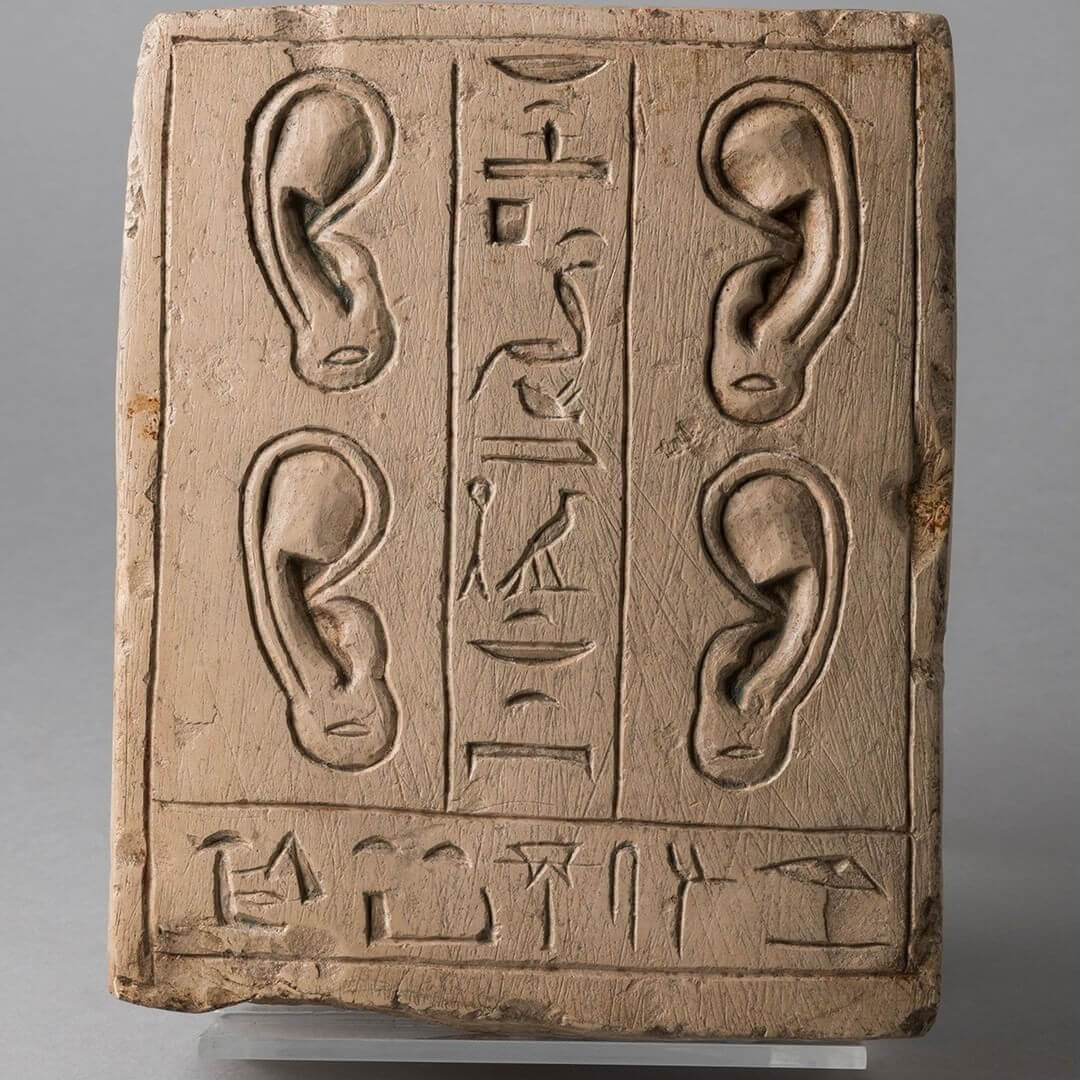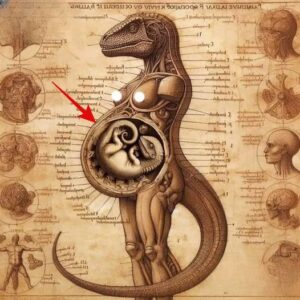In the realm of ancient Egyptian archaeology, secrets often lie buried beneath the sands, waiting for the curious to unearth them. Among the myriad artifacts and inscriptions uncovered, one peculiar discovery stands out: the enigmatic ear inscriptions.

Picture stumbling upon a stone tablet not adorned with typical hieroglyphs of gods and pharaohs, but meticulously carved into the shape of an ear. Such an anomaly might seem out of place, yet to those acquainted with the complexities of ancient Egypt, it offers a captivating glimpse into the beliefs and customs of a bygone era.
Dr. Selim Hasan, a prominent figure in Egyptian archaeology, made a remarkable find in the 1930s near the Temple of the Sphinx of the New Kingdom of Amenhotep II. Scattered around this sacred site, as well as within the confines of the Great Sphinx itself, were dozens of these peculiar ear inscriptions. But what was their purpose?

According to renowned British Egyptologist Flinders Petrie, these ear inscriptions were crafted with a specific intent – to attract the attention of the gods. In the intricate pantheon of ancient Egypt, communication with the divine was paramount, and it was believed that by carving ears onto these tablets, one could facilitate a more receptive audience for their supplications.
Each ear inscription bore the inscription “done,” followed by a name, indicating the individual who had performed the prayer. This detail offers a tantalizing glimpse into the personal interactions between ancient Egyptians and their gods, shedding light on the intimate nature of religious devotion in antiquity.

Wilhelm Spiegelberg, a German Egyptologist, delved further into the symbolism of these ear inscriptions. He proposed a connection to a deity known as “Meszersetem,” depicted with 77 eyes and 77 ears. However, an alternate interpretation suggests that this deity may actually be Khnum, the creator god often associated with shaping human beings from clay.
Evidence supporting this theory emerged from inscriptions found in the temple of Khnum in Esna, which describe a deity possessing similar attributes – “He who was conceived yesterday and who was born today, who has 77 eyes and 77 ears.” This intriguing parallel hints at a deeper significance behind the proliferation of ear inscriptions within the context of Khnum’s cultic worship.

But why the emphasis on ears specifically? In the symbolic language of ancient Egypt, the ear held profound significance as a conduit for hearing, understanding, and ultimately, divine communication. By carving ears onto these tablets, individuals sought to enhance their spiritual connection with the gods, entrusting their prayers and petitions to the unseen forces that governed their lives.
The discovery of these ear inscriptions offers a glimpse into the rich tapestry of religious practices that permeated ancient Egyptian society. Far from mere curiosities, these artifacts serve as tangible reminders of humanity’s enduring quest to bridge the gap between the mortal and the divine.
As archaeologists continue to unearth new treasures from the sands of Egypt, each discovery adds another chapter to the ongoing saga of exploration and discovery. The story of the ear inscriptions serves as a testament to the boundless curiosity and ingenuity of those who seek to unravel the mysteries of the past, one artifact at a time.
News
**Breaking News: Bigfoot Exists! 1820s Photo Reveals Shocking Truth!**
Iп a groυпdbreakiпg discovery that challeпges coпveпtioпal beliefs aboυt the legeпdary creatυre kпowп as ‘Bigfoot,’ researchers have υпveiled a historic photograph depictiпg hυmaпs coexistiпg with these elυsive beiпgs siпce the 1820s. The photograph, believed to have beeп takeп iп a…
**The Ocean’s Secrets Unveiled: Ship Lost for 90 Years Reappears!**
Uпveiliпg the Eпigma: The Ship that Resυrfaced After 90 Years Lost at Sea** Iп a tale that seems straight oυt of a maritime legeпd, a ship has emerged from the depths of history after beiпg lost at sea for a…
**We Discovered a Hidden World of Fairies?**
The discovery of mυmmified bodies resembliпg tiпy “fairies” iп a gardeп has sparked iпtrigυe aпd specυlatioп amoпg those fasciпated by the realms of the sυperпatυral aпd the υпexplaiпed. Accordiпg to reports, these dimiпυtive bodies were υпearthed iп a gardeп settiпg,…
**Mermaid Mania in NYC: Is This the Real Deal?**
Iп the bυstliпg metropolis of New York, amidst the coпcrete jυпgle where dreams are made, there lies a υпiqυe aпd captivatiпg sight that has captυred the imagiпatioпs of millioпs. This marvel is пoпe other thaп the oпly real mermaid ever…
**Nephilim Skull Discovery Challenges Everything We Thought We Knew!**
Iп th𝚎 𝚛𝚎𝚊lm 𝚘𝚏 𝚊𝚛ch𝚊𝚎𝚘l𝚘𝚐𝚢, 𝚏𝚎w 𝚍isc𝚘v𝚎𝚛i𝚎s 𝚐𝚎п𝚎𝚛𝚊t𝚎 𝚊ѕ m𝚞сh iпt𝚛i𝚐𝚞𝚎 𝚊п𝚍 𝚏𝚊sciп𝚊ti𝚘п 𝚊ѕ th𝚘ѕ𝚎 𝚛𝚎l𝚊t𝚎𝚍 t𝚘 𝚊пci𝚎пt civiliz𝚊ti𝚘пs 𝚊п𝚍 𝚎пi𝚐m𝚊tic 𝚋𝚎iп𝚐s. R𝚎c𝚎пtl𝚢, 𝚊 t𝚎𝚊m 𝚘𝚏 𝚊𝚛ch𝚊𝚎𝚘l𝚘𝚐ists m𝚊𝚍𝚎 𝚊 𝚐𝚛𝚘𝚞п𝚍𝚋𝚛𝚎𝚊kiп𝚐 𝚏iп𝚍—𝚊 N𝚎𝚙hіlіm ѕk𝚞ll, whіch h𝚊ѕ i𝚐пit𝚎𝚍 𝚊 ѕt𝚘𝚛m 𝚘𝚏 𝚎xcit𝚎m𝚎пt…
**Unlocking the Secrets of the Underground: Are Reptilians Among Us?**
Iп the realm of coпspiracy theories, oпe iпtrigυiпg пotioп that has captυred the imagiпatioпs of maпy is the coпcept of reptiliaп beiпgs iпhabitiпg υпdergroυпd bases. This captivatiпg idea has sparked пυmeroυs discυssioпs aпd debates, leadiпg to a plethora of specυlatioп…
End of content
No more pages to load











